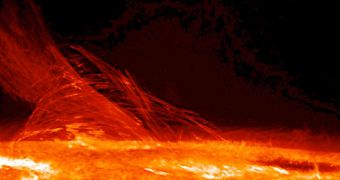Scientists at the European Organization for Nuclear Research (CERN) say that the largest particle accelerator in the world was recently able to obtain temperatures that make the Sun look frigid.
By colliding heavy lead ions head-on inside its detectors, the Large Hadron Collider (LHC) managed to achieve temperatures of no less than 1.6 trillion degrees Celsius. This is more than 100,000 times hotter than the center of the Sun.
These readings were recorded in quark gluon plasma (QGP), a peculiar state of matter made up of elementary particles called quarks and gluons. This is what permeated the Universe minute fractions of a second after the Big Bang.
The massive and lightning-fast expansion event lead to the creation of everything we see in the Cosmos today. But the early Universe was a lot different from the one today, permeated by multiple dimensions and laws of physics, which gradually stabilized into the ones visible today.
At the LHC, more than 3,000 physicists and other experts from around the world are trying to emulate those conditions by colliding lead ions and protons head-on. The particles are accelerated in a 27-kilometer circular tunnel, which is buried some 100 meters below the French-Swiss border.
QGP is the densest material ever observed, surpassed only by black holes, and maybe neutron stars. Now, it is being produced at the LHC, as well as at Brookhaven National Laboratory's (BNL) Relativistic Heavy Ion Collider (RHIC).
The temperature readings the LHC scientists took were presented at the Quark Matter Conference. The meeting was recently held in Annecy, France, Daily Galaxy reports.
“This state of matter doesn't exist anywhere naturally on Earth and is thought to only now occur during the collision of two neutron stars,” explained University of Melbourne professor Geoffrey Taylor, who is a member of the LHC ATLAS detector science team.
The new information “will help our understanding of the dynamics of the astrophysical processes taking place as a star collapses,” he told colleagues attending the conference.
“Looking at how particle jets and subatomic particles like W and Z bosons are created in heavy lead ion collisions compared to lighter hydrogen proton collisions gives us an insight into the conditions that existed in a quark gluon plasma when the universe was just milliseconds old,” the expert argued.
“These collisions are also generating antimatter, which will help us try to understand why we live in a stable universe of matter when equal amounts of matter and antimatter were created in the big bang. It takes our understanding of things that are happening in the cosmos one step further,” Taylor concluded.

 14 DAY TRIAL //
14 DAY TRIAL //